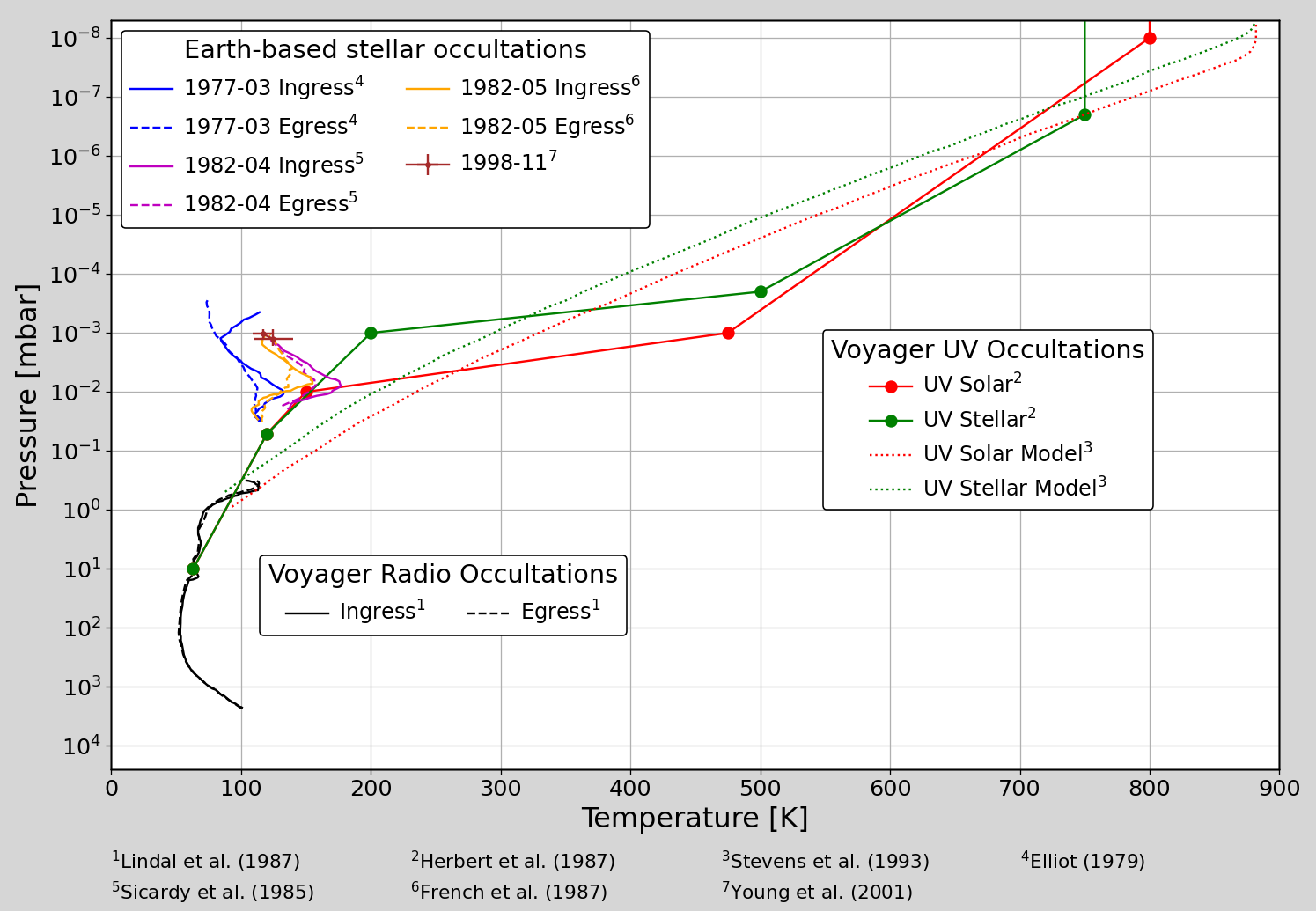Uranus Upper-Atmospheric Temperatures From Stellar Occultations
- 1Astronomy Department, Boston University, Boston, MA, United States (wsaund@bu.edu)
- 2Center for Space Physics, Boston University, Boston, MA, United States
- 3Department of Earth, Atmospheric, and Planetary Sciences, Massachusetts Institute of Technology, Cambridge, MA, United States
- 4Department of Astronomy, Wellesley College, Wellesley, MA, United States
Background: The atmospheres of Uranus and Neptune are the most poorly constrained fluid atmospheres in the solar system. The ice giants were only visited, briefly, by the Voyager 2 spacecraft in the late 1980s. At Uranus, the Voyager 2 UV stellar and solar occultations detected a warm stratosphere and extremely hot thermosphere [1, 2], far in excess of heating caused by solar irradiance alone [3, 4]. Furthermore, Uranus has far smaller internal energy production than the other giant planets [5, 6] as well as a surprisingly well-equilibrated stratosphere given its 98º obliquity [7]. As the energy balance of Uranus’ atmosphere is unknown, it is often called the “Giant Planet Energy Crisis.”
Motivation and Aims: Between 1977 and 1998, dozens of stellar occultations by Uranus were observed from Earth (see [8] and references therein). In an Earth-based stellar occultation, stellar flux is diminished by differential refraction through the occulting atmosphere and is observed as a light curve. The original analyses of these light curves found cooler stratospheric and lower thermospheric temperatures than Voyager 2. Figure 1 shows the tension between the Earth-based and Voyager measurements of the upper atmosphere of Uranus. It is now possible to reprocess these archival light curves using modern techniques and better compare them to the Voyager 2 temperature profiles.
Methods: To reprocess the Earth-based stellar occultation light curves, we use a two-part procedure. We first fit the light curve to a smooth atmospheric model with power law temperature gradient [9] to set a boundary condition. We next perform inversion, which assumes ray optics, small bending angles, hydrostatic equilibrium, and an ideal gas to solve for temperature, pressure, and number density at each flux measurement [10]. This procedure has been significantly improved since the original data were published, allowing for non-isothermal boundary conditions, accurate uncertainties on output quantities, and much higher vertical resolutions [11].
In addition to producing atmospheric profiles from observed occultation light curves, we do the reverse by simulating Earth-based stellar occultation light curves using the Uranian temperatures reported by Voyager 2 [12]. We can then compare the generated light curves directly to our suite of observed ones.
Results: We present the temperature-pressure profiles from reanalysis of many archival Earth-based occultations and compare them to the published Voyager 2 findings. Further, we present the comparison of our synthetic Earth-based light curves, generated from a forward model of the Voyager 2 temperatures, to the observed Earth-based light curves. We comment on how consistent the Voyager 2 UV occultation findings are with Earth-based stellar occultation observations. Finally, we offer a revised Uranus temperature-pressure profile for the stratosphere and lower thermosphere based on these findings.

Figure 1. Comparison of remote sensing measurements of the atmosphere of Uranus. Earth-based occultations are blue [13], magenta [14], yellow [15] and brown [8]; Voyager UV occultations are solid red and green [1]; models are dotted red and green [2]; Voyager radio occultations are black [16]. Error bars are absent from this figure because they were not provided in the original publications.
References
[1] Herbert, F., et al. (1987). JGR, 92, pp. 15093–15109.
[2] Stevens, M. H., et al. (1993). Icarus, 101, pp. 45–63.
[3] Marley, M. S., and McKay, C. P. (1999). Icarus, 268-286.
[4] Li, C., Le, T., Zhang, X, and Yung, Y. (2018). J Quant Spectrosc Ra, 353–362.
[5] Pearl, J. C., Conrath, B. J., Hanel, R. A., Pirraglia, J. A, Coustenis, A. (1990). Icarus, 12-28.
[6] Bishop, J., et al. (1995). Neptune and Triton, pp. 427–487, University of Arizona Press.
[7] West, R. A., and Lane, A. L. (1987). JGR, 92, 30-36.
[8] Young, L. A., et al. (2001). Icarus, 153, pp. 236–247.
[9] Elliot , L. A., and Young, L. A. (1992). AJ, 991.
[10] Elliot, J. L., Person, M. J., & Qu, S. (2003). AJ, 126, 1041-1079.
[11] Saunders, W. R., Person, M. J., Withers, P. (2021). AJ, 161, 280.
[12] Chamberlain, D. and Elliot, J. (1997). PASP, 109, pp. 1170–1180.
[13] Elliot, J. L. (1979). Annu. Rev. Astron. Astrophys., 17, pp. 445-475.
[14] Sicardy, B., et al. (1985). Icarus, 64 pp.88-106.
[15] French, R. G., et al. (1987). Icarus, 69, pp. 499–505.
[16] Lindal, G. F. et al. (1987). JGR, 92, pp. 14987–15001.
How to cite: Saunders, W., Person, M., Withers, P., and French, R.: Uranus Upper-Atmospheric Temperatures From Stellar Occultations, Europlanet Science Congress 2022, Granada, Spain, 18–23 Sep 2022, EPSC2022-758, https://doi.org/10.5194/epsc2022-758, 2022.

